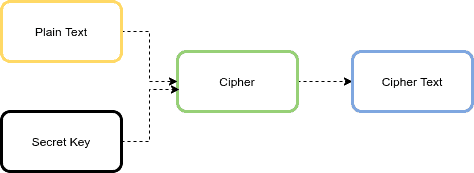1. 概述
对称密钥块密码在数据加密中起着重要作用,这意味着相同的密钥用于加密和解密。高级加密标准(AES)是一种广泛使用的对称密钥加密算法。
在本教程中,我们将学习如何使用JDK中的Java加密体系结构(JCA)实现AES加密和解密。
2. AES算法
AES算法是一种迭代的对称密钥块密码,它支持128、192和256位的加密密钥(密钥)以加密和解密128位块中的数据。下图显示了高级AES算法:
如果要加密的数据不满足128位的块大小要求,则必须进行填充。填充是将最后一个块填充到128位的过程。
3. AES变体
AES算法有6种操作模式:
- ECB(电子密码本)
- CBC(密码块链接)
- CFB(密码反馈)
- OFB(输出反馈)
- CTR(计数器)
- GCM(伽罗瓦/计数器模式)
我们可以应用操作模式来加强加密算法的效果。此外,操作模式可以将块密码转换为流密码。每种模式都有其优点和缺点,让我们快速回顾一下每一个。
3.1 ECB
这种操作模式是最简单的,明文被分成大小为128位的块,然后使用相同的密钥和算法对每个块进行加密。因此,它对同一个块产生相同的结果。这是该模式的主要弱点,不推荐用于加密。它需要填充数据。
3.2 CBC
为了克服ECB的弱点,CBC模式使用初始化向量(IV)来增强加密。首先,CBC使用明文块与IV异或,然后将结果加密到密文块中。在下一个块中,它使用加密结果与明文块进行异或,直到最后一个块。
在这种模式下,加密不能并行,但解密可以并行。它也需要填充数据。
3.3 CFB
这种模式可以用作流密码。首先,它对IV进行加密,然后与明文块进行异或运算得到密文。然后CFB对加密结果进行加密,对明文进行异或运算。它需要IV。
在这种模式下,解密可以并行,但加密不能并行。
3.4 OFB
这种模式可以用作流密码。首先,它加密IV,然后使用加密结果对明文进行异或得到密文。
它不需要填充数据,也不会受到噪声块的影响。
3.5 CTR
此模式使用计数器的值作为IV。它与OFB非常相似,但它每次都使用计数器而不是IV进行加密。
这种模式有两个优点,包括加密/解密并行化,并且一个块中的噪声不会影响其他块。
3.6 GCM
此模式是CTR模式的扩展,GCM受到了极大的关注,并被NIST推荐。GCM模型输出密文和身份验证标记。与算法的其他操作模式相比,这种模式的主要优点是它的效率。
在本教程中,我们将使用AES/CBC/PKCS5Padding算法,因为它在许多项目中被广泛使用。
3.7 加密后数据大小
如前所述,AES的块大小为128位或16字节。AES不改变大小,密文大小等于明文大小。另外,在ECB和CBC模式下,我们应该使用像PKCS5这样的填充算法。所以加密后的数据大小为:
ciphertext_size (bytes) = cleartext_size + (16 - (cleartext_size % 16))
为了用密文存储IV,我们需要再增加16个字节。
4. AES参数
在AES算法中,我们需要三个参数:输入数据、密钥和IV。IV不用于ECB模式。
4.1 输入数据
AES的输入数据可以是字符串、文件、对象和基于密码的。
4.2 密钥
在AES中有两种生成密钥的方法:从随机数生成,或从给定密码派生。
在第一种方法中,密钥应该从加密安全(伪)随机数生成器(如SecureRandom类)生成。
为了生成密钥,我们可以使用KeyGenerator类。让我们定义一个方法来生成大小为n(128、192和256)位的AES密钥:
public static SecretKey generateKey(int n) throws NoSuchAlgorithmException {
KeyGenerator keyGenerator = KeyGenerator.getInstance("AES");
keyGenerator.init(n);
SecretKey key = keyGenerator.generateKey();
return key;
}
在第二种方法中,可以使用基于密码的密钥派生函数(如PBKDF2)从给定的密码派生AES密钥。我们还需要一个盐值来将密码转换为密钥,盐也是一个随机值。
我们可以使用SecretKeyFactory类和PBKDF2WithHmacSHA256算法从给定的密码生成密钥。
让我们定义一种从给定密码生成AES密钥的方法,迭代次数为65536次,密钥长度为256位:
public static SecretKey getKeyFromPassword(String password, String salt) throws NoSuchAlgorithmException, InvalidKeySpecException {
SecretKeyFactory factory = SecretKeyFactory.getInstance("PBKDF2WithHmacSHA256");
KeySpec spec = new PBEKeySpec(password.toCharArray(), salt.getBytes(), 65536, 256);
SecretKey secret = new SecretKeySpec(factory.generateSecret(spec)
.getEncoded(), "AES");
return secret;
}
4.3 初始化向量(IV)
IV是一个伪随机值,与加密的块大小相同。我们可以使用SecureRandom类来生成随机IV。
让我们定义一个生成IV的方法:
public static IvParameterSpec generateIv() {
byte[] iv = new byte[16];
new SecureRandom().nextBytes(iv);
return new IvParameterSpec(iv);
}
5. 加密与解密
5.1 字符串
要实现输入字符串加密,我们首先需要根据上一节生成秘钥和IV。下一步,我们使用getInstance()方法从Cipher类创建一个实例。
此外,我们使用带有密钥、IV和加密模式的init()方法配置Cipher实例。最后,我们通过调用doFinal()方法来加密输入字符串,此方法获取输入字节并以字节为单位返回密文:
public static String encrypt(String algorithm, String input, SecretKey key, IvParameterSpec iv) throws NoSuchPaddingException, NoSuchAlgorithmException, InvalidAlgorithmParameterException, InvalidKeyException, BadPaddingException, IllegalBlockSizeException {
Cipher cipher = Cipher.getInstance(algorithm);
cipher.init(Cipher.ENCRYPT_MODE, key, iv);
byte[] cipherText = cipher.doFinal(input.getBytes());
return Base64.getEncoder()
.encodeToString(cipherText);
}
为了解密输入字符串,我们可以使用DECRYPT_MODE初始化我们的密码来解密内容:
public static String decrypt(String algorithm, String cipherText, SecretKey key, IvParameterSpec iv) throws NoSuchPaddingException, NoSuchAlgorithmException, InvalidAlgorithmParameterException, InvalidKeyException, BadPaddingException, IllegalBlockSizeException {
Cipher cipher = Cipher.getInstance(algorithm);
cipher.init(Cipher.DECRYPT_MODE, key, iv);
byte[] plainText = cipher.doFinal(Base64.getDecoder()
.decode(cipherText));
return new String(plainText);
}
让我们编写一个加密和解密字符串输入的测试方法:
@Test
void givenString_whenEncrypt_thenSuccess() throws NoSuchAlgorithmException, IllegalBlockSizeException, InvalidKeyException, BadPaddingException, InvalidAlgorithmParameterException, NoSuchPaddingException {
String input = "tuyucheng";
SecretKey key = AESUtil.generateKey(128);
IvParameterSpec ivParameterSpec = AESUtil.generateIv();
String algorithm = "AES/CBC/PKCS5Padding";
String cipherText = AESUtil.encrypt(algorithm, input, key, ivParameterSpec);
String plainText = AESUtil.decrypt(algorithm, cipherText, key, ivParameterSpec);
Assertions.assertEquals(input, plainText);
}
5.2 文件
现在让我们使用AES算法加密文件。步骤是相同的,但我们需要一些IO类来处理这些文件。让我们加密一个文本文件:
public static void encryptFile(String algorithm, SecretKey key, IvParameterSpec iv, File inputFile, File outputFile) throws IOException, NoSuchPaddingException, NoSuchAlgorithmException, InvalidAlgorithmParameterException, InvalidKeyException, BadPaddingException, IllegalBlockSizeException {
Cipher cipher = Cipher.getInstance(algorithm);
cipher.init(Cipher.ENCRYPT_MODE, key, iv);
FileInputStream inputStream = new FileInputStream(inputFile);
FileOutputStream outputStream = new FileOutputStream(outputFile);
byte[] buffer = new byte[64];
int bytesRead;
while ((bytesRead = inputStream.read(buffer)) != -1) {
byte[] output = cipher.update(buffer, 0, bytesRead);
if (output != null) {
outputStream.write(output);
}
}
byte[] outputBytes = cipher.doFinal();
if (outputBytes != null) {
outputStream.write(outputBytes);
}
inputStream.close();
outputStream.close();
}
请注意,不建议尝试将整个文件(尤其是大文件)读入内存。相反,我们一次加密一个缓冲区。
为了解密文件,我们使用类似的步骤并使用我们之前看到的DECRYPT_MODE初始化我们的密码。
同样,让我们定义一个用于加密和解密文本文件的测试方法。在这个方法中,我们从测试资源目录中读取tuyucheng.txt文件,将其加密成一个名为tuyucheng.encrypted的文件,然后将该文件解密成一个新文件:
@Test
void givenFile_whenEncrypt_thenSuccess() throws NoSuchAlgorithmException, IOException, IllegalBlockSizeException, InvalidKeyException, BadPaddingException, InvalidAlgorithmParameterException, NoSuchPaddingException {
SecretKey key = AESUtil.generateKey(128);
String algorithm = "AES/CBC/PKCS5Padding";
IvParameterSpec ivParameterSpec = AESUtil.generateIv();
Resource resource = new ClassPathResource("inputFile/tuyucheng.txt");
File inputFile = resource.getFile();
File encryptedFile = new File("classpath:tuyucheng.encrypted");
File decryptedFile = new File("document.decrypted");
AESUtil.encryptFile(algorithm, key, ivParameterSpec, inputFile, encryptedFile);
AESUtil.decryptFile(algorithm, key, ivParameterSpec, encryptedFile, decryptedFile);
assertThat(inputFile).hasSameTextualContentAs(decryptedFile);
}
5.3 基于密码
我们可以使用从给定密码派生的密钥进行AES加密和解密。
为了生成密钥,我们使用getKeyFromPassword()方法。加解密步骤与字符串输入部分相同,然后我们可以使用实例化的Cipher和提供的密钥来执行加密。
让我们编写一个测试方法:
@Test
void givenPassword_whenEncrypt_thenSuccess() throws InvalidKeySpecException, NoSuchAlgorithmException, IllegalBlockSizeException, InvalidKeyException, BadPaddingException, InvalidAlgorithmParameterException, NoSuchPaddingException {
String plainText = "www.tuyucheng.com";
String password = "tuyucheng";
String salt = "12345678";
IvParameterSpec ivParameterSpec = AESUtil.generateIv();
SecretKey key = AESUtil.getKeyFromPassword(password,salt);
String cipherText = AESUtil.encryptPasswordBased(plainText, key, ivParameterSpec);
String decryptedCipherText = AESUtil.decryptPasswordBased(cipherText, key, ivParameterSpec);
Assertions.assertEquals(plainText, decryptedCipherText);
}
5.4 对象
为了加密Java对象,我们需要使用SealedObject类,该对象应该是可序列化的。让我们从定义一个Student类开始:
public class Student implements Serializable {
private String name;
private int age;
// standard setters and getters
}
接下来,让我们加密Student对象:
public static SealedObject encryptObject(String algorithm, Serializable object, SecretKey key, IvParameterSpec iv) throws NoSuchPaddingException, NoSuchAlgorithmException, InvalidAlgorithmParameterException, InvalidKeyException, IOException, IllegalBlockSizeException {
Cipher cipher = Cipher.getInstance(algorithm);
cipher.init(Cipher.ENCRYPT_MODE, key, iv);
SealedObject sealedObject = new SealedObject(object, cipher);
return sealedObject;
}
加密的对象稍后可以使用正确的密码进行解密:
public static Serializable decryptObject(String algorithm, SealedObject sealedObject, SecretKey key, IvParameterSpec iv) throws NoSuchPaddingException, NoSuchAlgorithmException, InvalidAlgorithmParameterException, InvalidKeyException, ClassNotFoundException, BadPaddingException, IllegalBlockSizeException, IOException {
Cipher cipher = Cipher.getInstance(algorithm);
cipher.init(Cipher.DECRYPT_MODE, key, iv);
Serializable unsealObject = (Serializable) sealedObject.getObject(cipher);
return unsealObject;
}
现在让我们编写一个测试用例:
@Test
void givenObject_whenEncrypt_thenSuccess() throws NoSuchAlgorithmException, IllegalBlockSizeException, InvalidKeyException, InvalidAlgorithmParameterException, NoSuchPaddingException, IOException, BadPaddingException, ClassNotFoundException {
Student student = new Student("Baeldung", 20);
SecretKey key = AESUtil.generateKey(128);
IvParameterSpec ivParameterSpec = AESUtil.generateIv();
String algorithm = "AES/CBC/PKCS5Padding";
SealedObject sealedObject = AESUtil.encryptObject(algorithm, student, key, ivParameterSpec);
Student object = (Student) AESUtil.decryptObject(algorithm, sealedObject, key, ivParameterSpec);
assertThat(student).isEqualToComparingFieldByField(object);
}
6. 总结
在本文中,我们学习了如何使用Java中的AES算法加密和解密输入数据,例如字符串、文件、对象和基于密码的数据。此外,我们还讨论了AES变体和加密后的数据大小。
与往常一样,本教程的完整源代码可在GitHub上获得。
Post Directory

